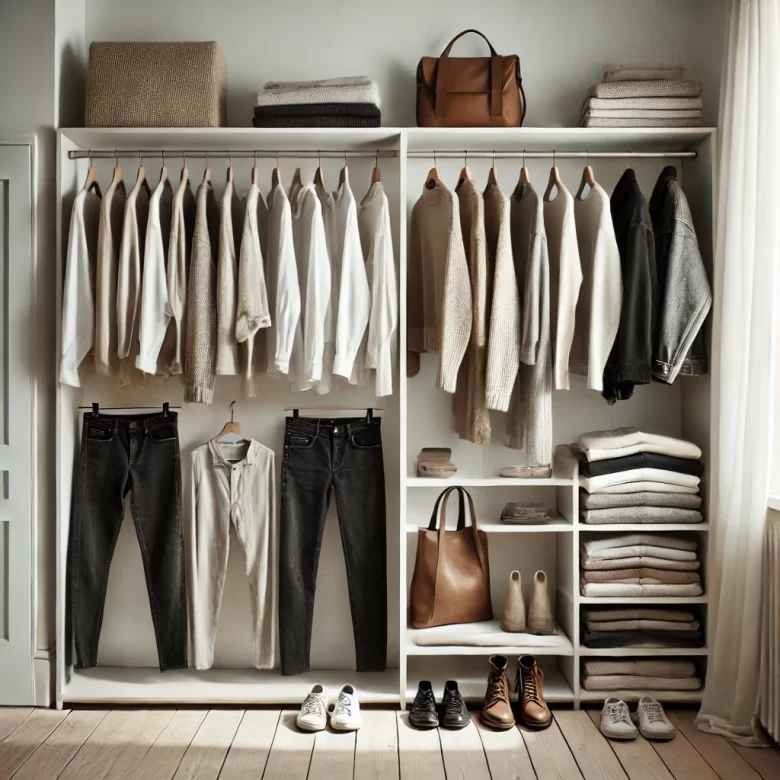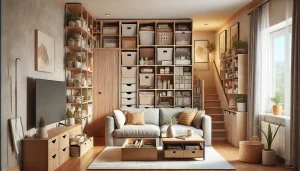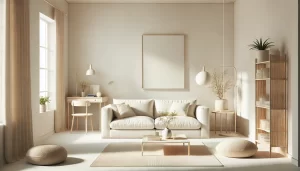Introduction
In recent years, the fashion industry has seen a shift towards minimalism and sustainability, as more people are becoming conscious of the environmental impact of their clothing choices. The idea of creating a wardrobe with fewer, carefully chosen pieces that are functional, versatile, and made to last is gaining popularity. A minimalist wardrobe doesn’t just mean owning less; it’s about making thoughtful, intentional decisions that align with your values, reducing waste, and supporting ethical practices in fashion.
By focusing on a small, functional wardrobe, you can simplify your daily choices, save time, and feel more confident in your style. Instead of constantly being overwhelmed by too many options, you can create outfits that truly reflect your personality and suit your lifestyle. The key here is quality over quantity—choosing well-made, durable pieces that stand the test of time rather than constantly chasing the latest trends. This not only benefits your wardrobe but also contributes significantly to sustainability, as it reduces the need for fast fashion and minimizes waste. When you invest in fewer, better-quality items, you’re not just improving your closet—you’re also making a positive impact on the environment.
Why a Few Pieces Can Be Enough
The concept of a “capsule wardrobe” has been gaining traction in recent years as a minimalist approach to clothing. At its core, a capsule wardrobe is a collection of timeless, versatile pieces that can be mixed and matched to create a wide range of outfits. Rather than filling your closet with countless trendy items, a capsule wardrobe focuses on fewer, higher-quality pieces that serve multiple purposes and can be worn year-round. The beauty of this concept lies in its simplicity, allowing you to streamline your closet while still maintaining a stylish, functional wardrobe.
One of the most significant reasons for embracing a capsule wardrobe is its environmental impact. The fashion industry is one of the largest polluters globally, with fast fashion contributing to massive waste and overconsumption. By constantly purchasing cheap, low-quality items that are worn only a few times before being discarded, we are perpetuating a cycle of environmental harm. In contrast, a smaller, curated wardrobe promotes sustainability by reducing the demand for fast fashion and encouraging mindful consumption. When you choose quality over quantity, you’re supporting brands that prioritize ethics and durability, ultimately contributing to a more sustainable future.
Additionally, a minimalist wardrobe has psychological benefits that go beyond environmental concerns. With fewer clothing options, you can experience less decision fatigue. The constant pressure to choose from an overflowing closet can be exhausting, but a smaller wardrobe makes it easier to select outfits that align with your style and needs. This streamlined approach also helps develop a clearer sense of personal style, as you’re able to focus on the pieces that truly resonate with you. With a curated selection of well-loved items, getting dressed becomes a more enjoyable and stress-free experience. Ultimately, owning fewer pieces doesn’t mean sacrificing style or functionality—in fact, it allows you to appreciate what you have while reducing the clutter that can often cause unnecessary stress.
Key Elements of a Functional Wardrobe
Creating a functional wardrobe starts with selecting versatile pieces that can be easily mixed and matched to create a variety of looks. The key to this is choosing timeless essentials that never go out of style and serve as the foundation of your closet. Items like basic t-shirts, well-fitting jeans, neutral outerwear, and classic button-down shirts are perfect examples of pieces that can be worn across different occasions and seasons. By having a core collection of reliable, simple clothing, you open up endless possibilities for creating different outfits, all while maintaining a cohesive, stylish wardrobe.
When building a functional wardrobe, one of the most important principles to follow is quality over quantity. Instead of filling your closet with numerous cheap, low-quality items that won’t stand the test of time, it’s better to invest in durable, well-made pieces. High-quality clothing might have a higher upfront cost, but it pays off in the long run because these items last longer, look better over time, and ultimately save you money by reducing the need for constant replacements. Well-crafted garments also retain their shape and color after multiple washes, keeping your wardrobe looking fresh and polished for years.
Neutral colors and simple designs are also key to creating a functional wardrobe. Opting for colors like black, white, gray, navy, and beige allows you to mix and match your pieces effortlessly. These shades tend to complement each other well, creating a cohesive look across your entire wardrobe. Neutral tones also offer more flexibility in styling, as they pair well with statement accessories or bold prints, allowing you to experiment with different looks without feeling overwhelmed by clashing colors or patterns. A wardrobe based on neutral colors will ensure that everything works together, so you never have to worry about whether an item matches or not.
Another smart strategy is to choose multi-purpose items—pieces that can serve more than one function or be worn in various settings. For example, a sleek blazer can work for both professional and casual occasions when paired with different pieces. A pair of black trousers can easily transition from work to evening outings. Investing in items like these maximizes your wardrobe’s potential, as they can be dressed up or down depending on the occasion. By incorporating versatile, multi-purpose pieces, you can create a functional wardrobe that adapts to your needs, no matter the situation.
Building Your Sustainable Wardrobe
Building a sustainable wardrobe is a thoughtful, step-by-step process that focuses on quality, longevity, and mindfulness in your clothing choices. By curating your closet with intention, you can create a wardrobe that is not only functional and stylish but also aligned with your environmental and ethical values. Here’s how you can build a wardrobe that reflects these principles:
Assessing Your Current Closet and Decluttering
Before you begin adding new items to your wardrobe, take a close look at what you already own. Start by decluttering your closet—this means removing clothes that no longer fit, that you haven’t worn in over a year, or that don’t align with your personal style. This process helps you get a clearer sense of what you actually need and what you can live without. It also helps identify the pieces that are in good condition and worth keeping versus those that may need to be repaired or replaced.
Identifying Gaps in Your Wardrobe
Once your closet is decluttered, the next step is to identify the gaps in your wardrobe. Look at what you’ve kept and assess what you’re still missing to create a well-rounded collection of clothing. Do you need more versatile basics, like a neutral cardigan or a pair of classic black shoes? Are there any pieces that can fill multiple roles in your wardrobe, like a blazer that works both at the office and for casual outings? The goal is to focus on filling these gaps with high-quality, timeless items that you can wear in different settings and that complement your existing pieces.
Setting a Sustainable Shopping Strategy
Shopping sustainably doesn’t mean you have to sacrifice style. Start by setting a strategy that includes buying second-hand, opting for eco-friendly brands, and making more conscious purchasing decisions. Thrift stores and online resale platforms like Poshmark or Depop are great sources for finding high-quality, pre-loved items at a fraction of the price. Additionally, look for brands that prioritize sustainability by using eco-friendly materials and transparent, ethical production practices. Take the time to research these companies and their commitment to sustainability before you buy, ensuring your purchases support the right causes.
Sustainable Fabric Choices
When selecting new pieces for your wardrobe, consider fabrics that are more sustainable and less harmful to the environment. Organic cotton, hemp, and bamboo are natural fibers that require fewer chemicals and pesticides during production. Recycled fabrics, such as recycled polyester, are also a good option, as they reduce the need for virgin materials and help keep textiles out of landfills. Other eco-friendly options include Tencel (made from sustainably sourced wood pulp) and wool from ethical sources. These materials not only contribute to a more sustainable wardrobe but are also often more durable and comfortable.
Choosing Brands with Ethical Practices
One of the most important aspects of building a sustainable wardrobe is supporting brands that practice ethical production. This means looking for companies that pay fair wages to workers, provide safe working conditions, and use sustainable materials. Many brands now offer transparency about their supply chains, so take the time to research them before making a purchase. Look for certifications like Fair Trade, Global Organic Textile Standard (GOTS), or B Corp to ensure that the brands you buy from are committed to sustainability and ethical practices.
Repair and Upcycle: Giving Your Clothes a Second Life
A key component of sustainable fashion is extending the lifespan of your clothes. Instead of discarding items that have small tears or missing buttons, consider repairing them. Many garments can be easily fixed with basic sewing skills, or you can take them to a tailor for more complex repairs. Upcycling is another great way to breathe new life into old clothing. Turn an old shirt into a new bag or add embellishments to a faded dress. By caring for your clothes and getting creative with upcycling, you can reduce waste and make your wardrobe truly sustainable.
Building a sustainable wardrobe is not just about reducing consumption; it’s about making intentional, informed choices that will benefit both you and the planet in the long run. With thoughtful planning, sustainable shopping habits, and a commitment to quality, you can create a wardrobe that’s not only functional but also eco-friendly and ethical.
Styling Tips for a Small Wardrobe
With a smaller, curated wardrobe, you might initially feel concerned that your options are limited, but in reality, a minimalist approach can be a great opportunity to get creative with your clothing. By mastering the art of mixing and matching, you can create countless outfits from just a few pieces, making your wardrobe more versatile and functional than ever before. Here are some styling tips to help you make the most out of your minimalist wardrobe:
How to Make the Most Out of a Few Pieces (Mix and Match Ideas)
The key to getting the most out of a small wardrobe is versatility. Start by focusing on pieces that can easily be combined with each other in different ways. For example, a classic white button-down shirt can be worn tucked into jeans for a casual look, or layered under a blazer for a more polished, professional outfit. A neutral-colored cardigan can be paired with a dress for added warmth or worn over a t-shirt and jeans for a laid-back, everyday outfit. By choosing timeless pieces in neutral colors, you give yourself the flexibility to mix and match items without worrying about clashing patterns or colors.
Additionally, focus on layering. A simple dress can be transformed into a whole new outfit with the addition of a jacket, scarf, or belt. Experiment with different combinations to keep things fresh and exciting without needing to add more items to your wardrobe. You’ll find that with a little creativity, the same pieces can take you from work to weekend and from day to night.
Using Accessories to Transform Looks and Add Variety
Accessories are your secret weapon when it comes to making a small wardrobe feel like it has endless possibilities. A few key accessories can completely transform an outfit and give it a new vibe. Scarves, hats, belts, jewelry, and shoes can all be used to add variety and personality to your look without requiring you to buy new clothes.
For example, a simple black dress can be dressed up for a night out with statement jewelry and a pair of heels, or dressed down for a casual day with sneakers and a denim jacket. A versatile scarf can be worn around your neck, as a headband, or even as a belt, providing multiple styling options for one item. By rotating accessories and incorporating them into different outfits, you can give your minimalist wardrobe a fresh look every time.
Tips on Dressing for Different Occasions with a Minimalist Wardrobe
A minimalist wardrobe can easily be adapted for a variety of occasions, from formal events to casual outings. The key is to focus on layering, accessorizing, and choosing versatile pieces that can be dressed up or down. Here are a few tips for different situations:
Work or Professional Settings: A tailored blazer, a button-down shirt, or a pair of high-waisted trousers can work seamlessly in a professional environment. To keep things interesting, pair these with different accessories like a sleek leather bag, a watch, or a pair of statement shoes.
Casual Days: For casual settings, stick with comfortable yet stylish basics like well-fitted jeans, a simple t-shirt, or a cozy sweater. You can add a fun twist with casual accessories, such as a crossbody bag, colorful sneakers, or a beanie.
Evening or Special Occasions: For nights out or more formal events, transform your basic pieces by adding elegant accessories. A little black dress can be dressed up with a bold necklace, high heels, and a chic clutch. Alternatively, a simple blouse can be paired with a stylish skirt and dressy shoes for an effortless yet sophisticated look.
By focusing on the versatility of your clothing and being creative with accessories, you can easily adapt your minimalist wardrobe to fit any occasion. With just a few carefully chosen pieces, you’ll find that less really is more, and you’ll have a closet full of endless possibilities at your fingertips.
Visual Inspiration: Curated Minimalist Wardrobes
For further inspiration, many influencers and minimalism advocates share their curated, sustainable wardrobes online, providing valuable insight into how to build and style a small, functional closet. On Instagram and Pinterest, you can find visuals of tidy, well-organized wardrobes filled with neutral-toned clothing, highlighting the power of simplicity and versatility. These photos often showcase how few pieces can look chic and sophisticated when styled thoughtfully.
For example, influencer Greta of The Sustainable Edit posts her capsule wardrobe every season, showing how she maximizes her pieces by layering and accessorizing. Her well-curated wardrobe is full of pieces that transition seamlessly from workwear to weekend looks, and her style is a testament to how functional and fashionable a minimalist closet can be. By following these examples, you can gain a visual understanding of how easy it is to keep your wardrobe minimal yet stylish.
Success Stories and Positive Impact
Building a functional, sustainable wardrobe has the potential to positively impact not just your fashion choices, but your overall lifestyle. For many individuals who have embraced this approach, the process has been a journey toward more mindful living. Reducing the excess in their wardrobes has helped them focus on what truly matters, from investing in experiences over new purchases to reducing stress related to decision fatigue.
For example, blogger Erin of “The Minimalist Wardrobe” shares how simplifying her closet has allowed her to embrace a more minimalist lifestyle overall. She now spends less time shopping, has fewer clothes to clean and maintain, and enjoys the feeling of owning only what she truly loves. In turn, this has led her to prioritize other areas of her life, such as spending more time with family and dedicating energy to creative pursuits. Erin’s story reflects how building a functional wardrobe can have a ripple effect on your well-being and happiness.
These real-life examples prove that creating a functional, sustainable wardrobe is not only possible but incredibly rewarding. It’s about more than just reducing consumption—it’s about creating a wardrobe that works for your lifestyle, reflects your values, and gives you the confidence to wear what you truly love. As you look to build your own sustainable closet, let these inspiring individuals be a reminder that less really can be more.
Conclusion
In today’s fast-paced world of ever-changing trends and overconsumption, creating a functional and sustainable wardrobe is not just a fashion choice—it’s a step toward a more mindful, intentional lifestyle. By focusing on fewer, high-quality pieces, you can simplify your daily routine, reduce decision fatigue, and cultivate a clearer sense of personal style. The benefits of a well-curated wardrobe extend beyond fashion; it also has a significant positive impact on the environment by reducing waste, minimizing the demand for fast fashion, and supporting ethical practices in the industry.
Embracing minimalism and sustainability in your fashion choices can empower you to make more conscious decisions about what you wear, what you buy, and how you care for your clothes. It’s about choosing items that are built to last, opting for versatile pieces that can be worn in multiple ways, and investing in brands that prioritize both quality and ethics. With each thoughtful purchase, you contribute to a more sustainable and responsible fashion ecosystem.
As you embark on your own journey to create a more functional and sustainable wardrobe, I challenge you to start small. Begin by curating a few essential, high-quality pieces that you can mix and match to create various outfits. Over time, you’ll discover how easy and rewarding it is to live with less while still enjoying a stylish, versatile closet. Remember, it’s not about having more—it’s about having what you truly need and love. Start today, and let your wardrobe reflect both your personal style and your commitment to a more sustainable future.




